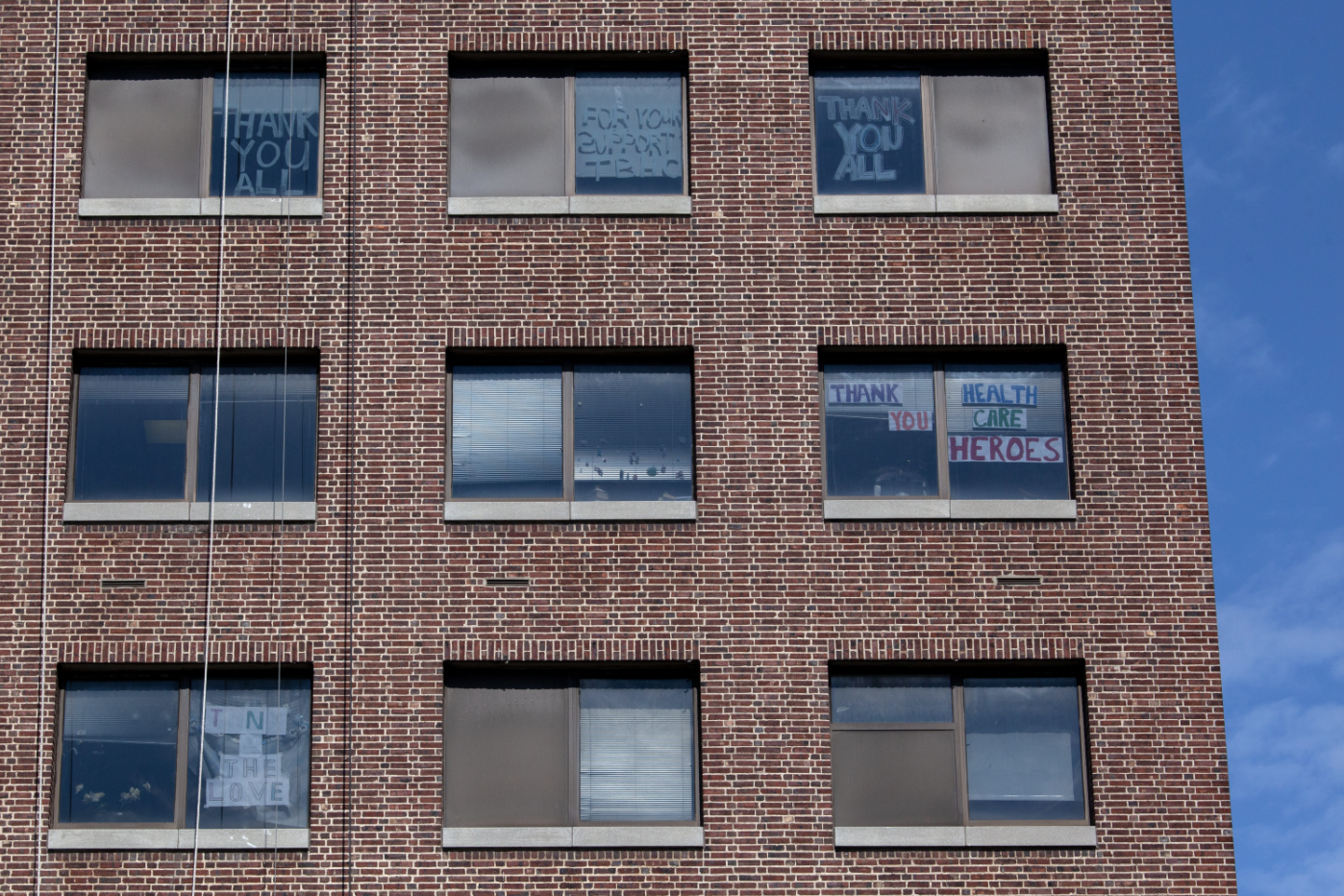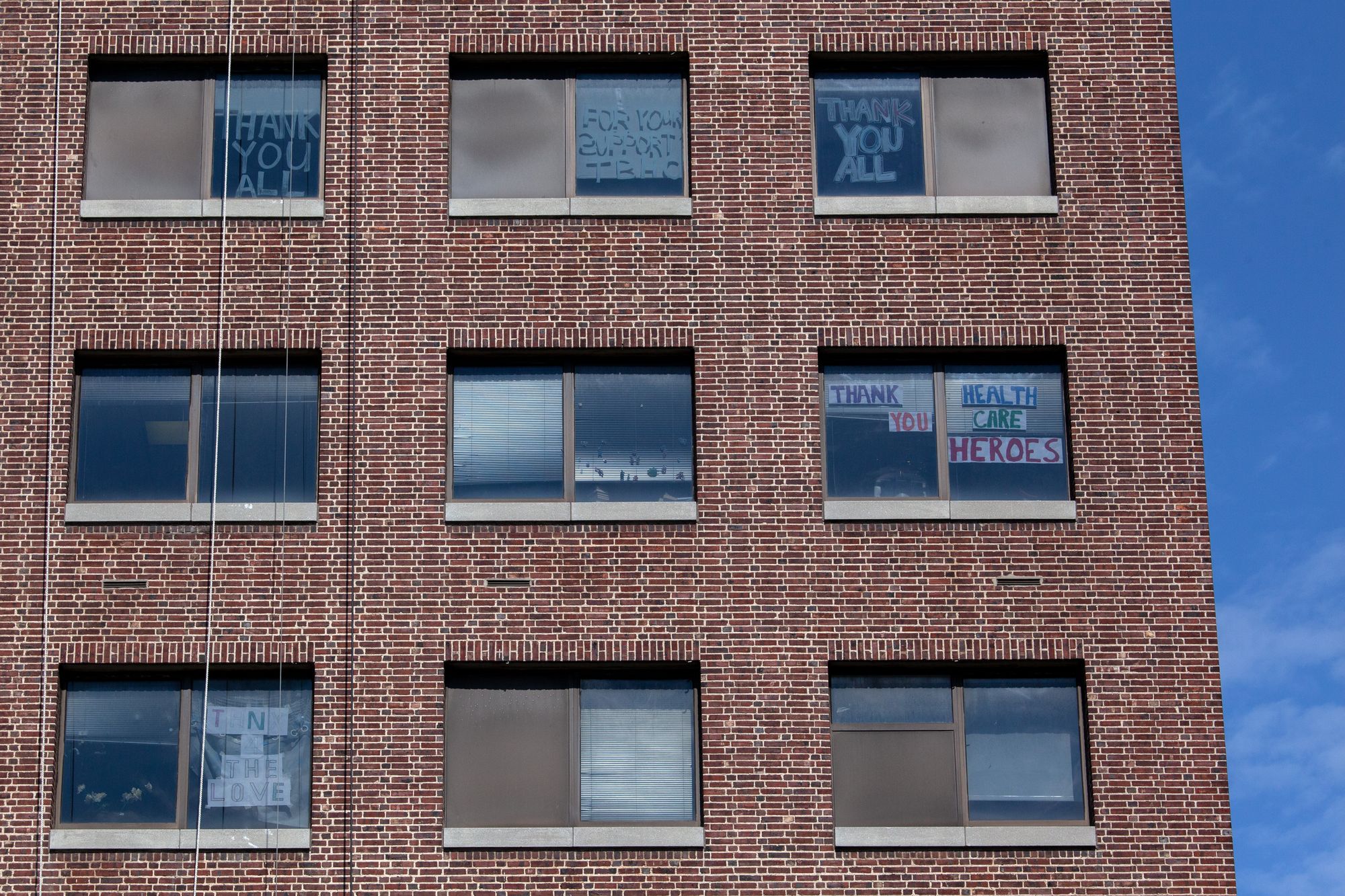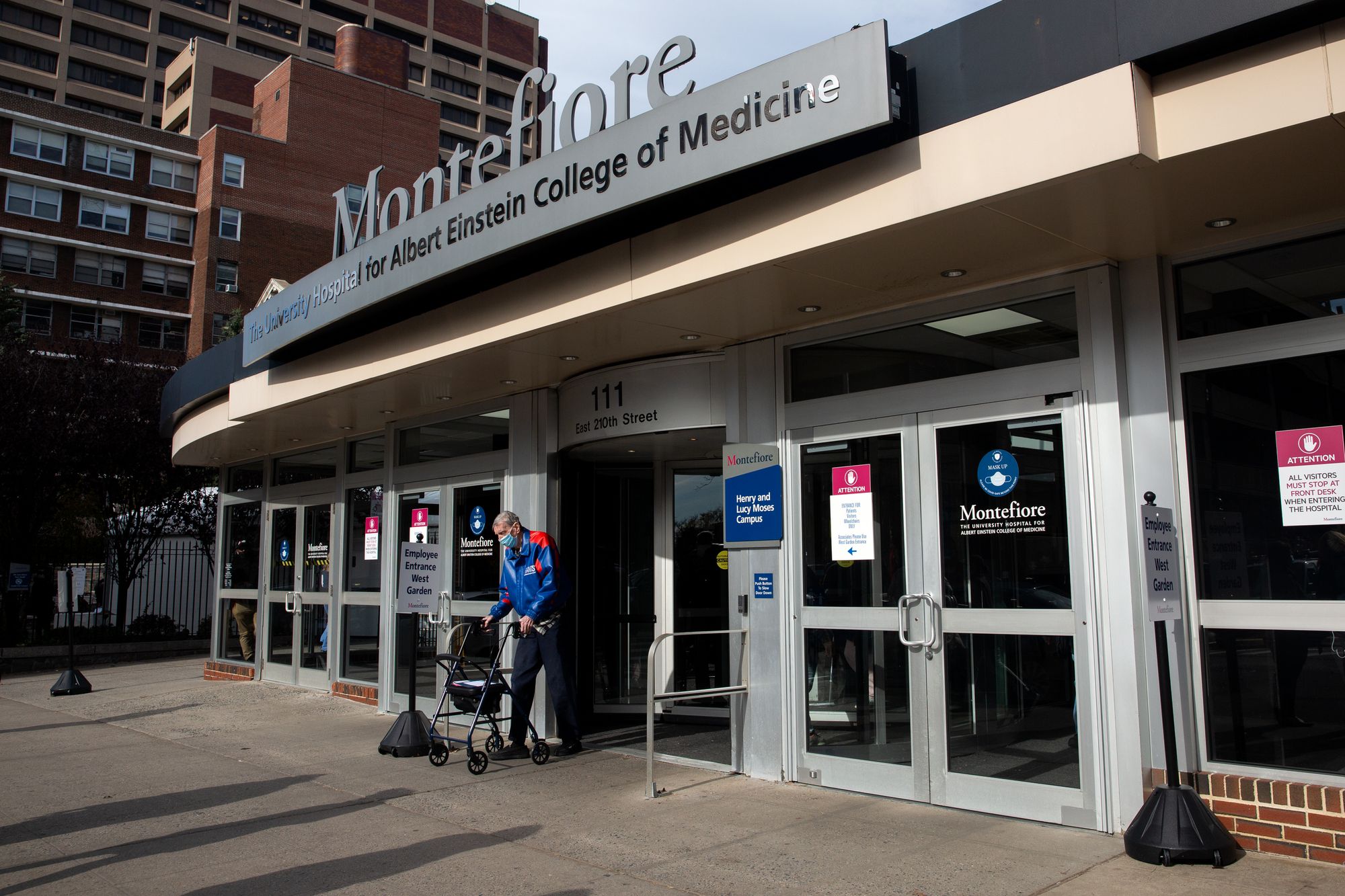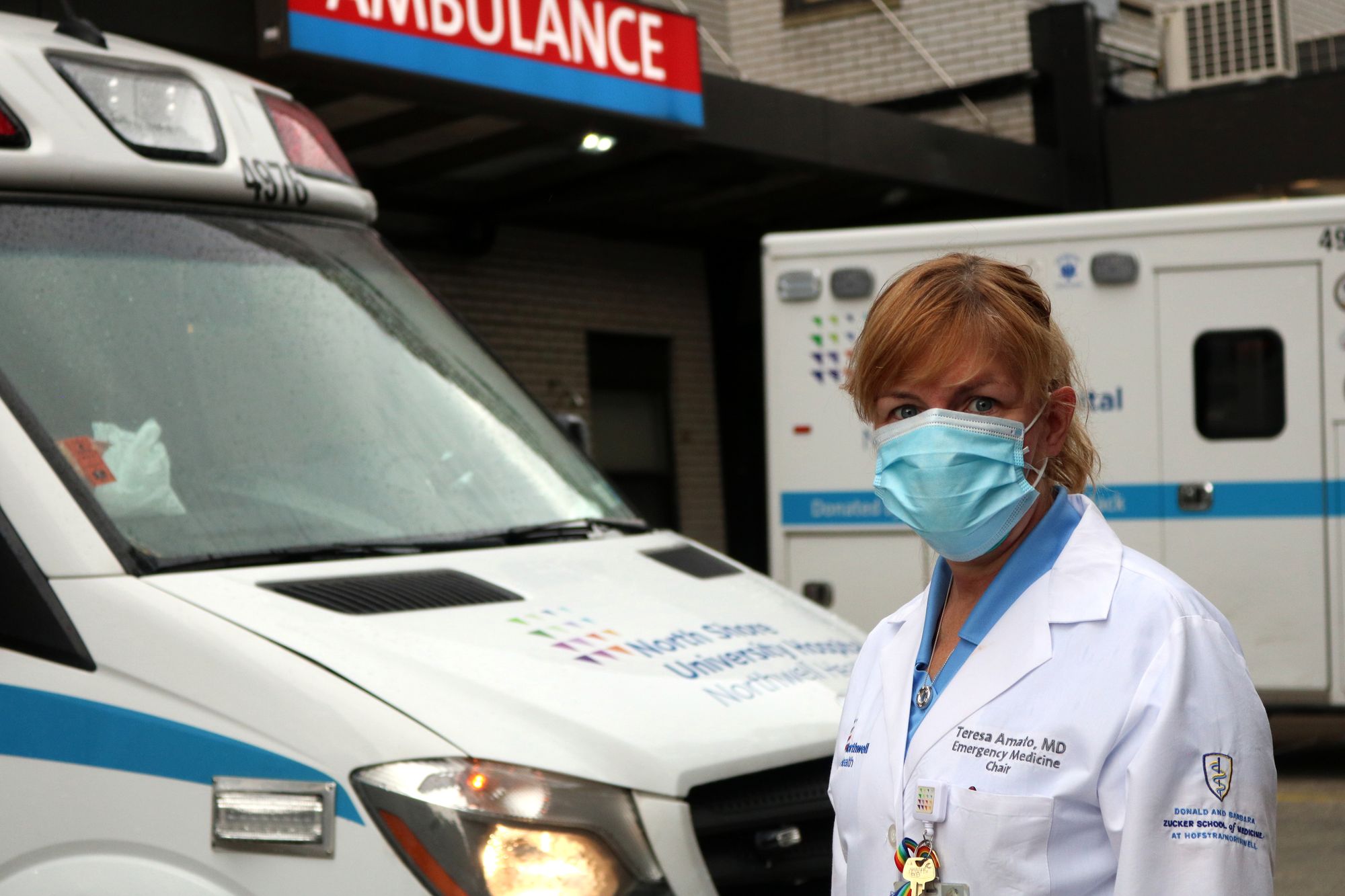At New York’s Hospitals, Staff Brace for Another COVID Wave: ‘We Know What’s Coming’

By Josefa Velasquez, Rachel Holliday Smith, and Greg B. Smith, THE CITY. This article was originally published by THE CITY

As the number of COVID-19 cases nationally reaches new heights and infections surge locally, New York City hospitals are seeing nothing like the influx of patients they treated during the spring outbreak — but they’re bracing for anything.
“Everybody’s terrified. We just think it’s going to be a big wave,” said Dr. Leonard Berkowitz, chief of infectious diseases at the Brooklyn Hospital Center. “The weather’s getting cold, people are going to be inside more, the holidays are coming up and people are going to ignore the rules about not getting together. We’re very concerned.”
As of Thursday, 746 COVID patients were being cared for in city hospitals — a number rising rapidly yet still far short of the 12,000-plus at April’s peak, when more than 1,500 patients arrived daily in desperate shape.
In the spring, 30% of those who entered New York City hospitals for COVID did not leave alive, a study released Thursday by the city Department of Health and Mental Hygiene and the U.S. Centers for Disease Control and Prevention found.

Still reeling from that experience, hospitals around the five boroughs have been preparing for months for the possibility of another surge, hoping to deploy the lessons they learned during an agonizing spring.
Hospitals are stockpiling months worth of face masks, shields, gowns and gloves so they don’t face shortages like those of eight months ago.
Yet nurses this week issued dire warnings that shortages of staff and protective gear may again plague health care providers and impede patient care. Some said they’re already seeing signs of a lack of equipment — including at city-run Bellevue Hospital where nurses are back to sometimes reusing masks.
On the positive side, COVID-19 treatments have also significantly advanced since the first case was reported in China a year ago.
“I feel much more prepared than we did in the spring. Much, much, much more prepared — and that’s because we know what we’re doing. We know what we need to treat these people,” said an emergency preparedness official at a large city hospital, who spoke to THE CITY on the condition of anonymity.
Still, the trauma of March and April — when hospitals were overflowing with patients, with mobile morgue trucks outside and health care workers wearing garbage bags and old masks — remain vivid as hospitals elsewhere in the United States become overrun.
And some health professionals say they’re alarmed by signs that some New Yorkers are flouting social distancing and mask-wearing guidelines more than eight months into the pandemic that’s killed over 24,000 in the city.
“It’s kind of like waiting for a bomb to go off,” said a nurse at Bellevue.
Fear, Dread and PPE
On Thursday, nurses at Montefiore Medical Center, serving The Bronx and lower Westchester County, rallied to call attention to what they say is a lack of preparedness in the event of a surge in coronavirus patients.
Montefiore’s Moses campus in the northern Bronx treated more COVID positive-patients during the first wave of the pandemic than any other hospital in New York City.
Nurses at the hospital say they’re still understaffed and lack protective equipment needed to care for patients.

Montefiore responded in a statement to THE CITY: “The medical community knows much more about COVID today than it did during the first surge; Montefiore is more prepared than ever, including a stock pile of PPE that exceeds the NYS DOH 90-day requirement.”
The hospital, among the city’s largest with more than 1,500 beds, isn’t currently among those seeing the most COVID patients, state data obtained by THE CITY shows.
Those are Staten Island University Hospital – North, with 61 coronavirus-positive patients as of early Thursday; Mount Sinai, with 52; Maimonides, with 49; and Methodist, NY-Presbyterian and Long Island Jewish, with 33 each.
By the end of Thursday, Staten Island University Hospital operator Northwell Health informed THE CITY, Staten Island North had 80 COVID patients in its care.
‘It Creates Anxiety’
At Staten Island North, registered nurse Dawn Cardello said dread of a COVID surge has triggered nurses there who remember well the nightmare of last spring’s first wave.
“It creates anxiety,” said Cardello, 55. “From what everybody went through in the spring, PTSD is definitely real. It’s rehashing what everybody went through.”
Cardello, a union rep for the New York State Nurses Association, said a key concern is whether staffing will be sufficient to handle a dramatic spike in COVID-19 patients.
Already the math of supply and demand is going in the wrong direction. She said a significant number of nurses have tested positive and are quarantining, while the number of COVID-positive patients continues to rise.
Gov. Andrew Cuomo designated much of Staten Island as a yellow zone last week because of a spike in cases there, with a 4.18% positivity rate among test results on Wednesday.
“We do have a lot of nurses who are on quarantine,” Cardello said. “A staffing issue is almost inevitable.”
Christian Preston, a spokesperson for Northwell, the hospital group that runs SIU North, wrote in an emailed response to THE CITY Thursday that “almost 90” of the hospital’s 6,500 staff have either tested positive or been exposed to someone who is positive and are currently quarantining. He said the hospital has a reserve of 7,500 employees — including retirees — it can tap into if necessary.
The union also has concerns about the adequacy of the protective gear supply going into the winter — a daily reminder of last spring’s mask shortage. Nurses must use the same mask for every patient they see during a shift, whether the patient is COVID-positive or not.
Preston wrote that the one-mask-per-shift protocol follows the guidance of the Centers for Disease Control and Prevention.
“We are very well prepared with the resources, PPE (personal protective equipment), staff and experience we need to treat these patients while keeping the hospital clean and safe for everyone,” he wrote.
Nevertheless, Cardello and her colleagues try to remain optimistic, and in the days leading up to Thanksgiving will work to get word out to the Staten Island community to wear masks, practice social distancing and avoid big family gatherings.
“We got through it the first time,” she said. “We can get through it again.”
Not Counting on Help
Nurses at Bellevue say they are sometimes forced to reuse rationed N95 masks for multiple shifts — and say staffing is already strained to the limit.
A veteran staffer said nurses are taking on extra tasks because medical workers who usually handle patient vital-signs monitoring have become scarce.

“I’m hearing it from all over the place of what we call ‘nobody on the floor’,” the staffer said.
Patient caseload is again back up to six and often seven patients per nurse, with the night staff often shouldering eight or nine per nurse, the staffer said. The ideal caseload is five patients per nurse.
Because the virus is now raging across the nation, Bellevue staff fear they will not be seeing the outside help they got last spring when nurses and doctors from around the country showed up to lend a hand.
“Now the rest of the country is undergoing the same s—t we were. There’s not going to be that availability to have those people swarm here,” the staffer said. “We’re currently stressed out to the max. If the coronavirus comes back in on top of it, that’s just nuts. And we will not get that same kind of cavalry coming in to rescue us. So God forbid it turns into that same thing.”
Late Thursday, the Department of Health and Mental Hygiene, which acts as the city’s pandemic command center, responded to THE CITY’s about its preparedness for a potential second COVID-19 wave.
In an email, spokesperson Patrick Gallahue wrote: “Following the Spring peak, we have used the time we had to prepare for any future resurgence. At the Mayor’s direction, we established a Medical Personal Protective Equipment Service Center that could supply the New York City healthcare sector with peak volumes of PPE from the Spring for a full 90 days and meet any ventilation needs we might have.”
Halloween Effect
The study released Thursday by the city Department of Health and Mental Hygiene and U.S. Centers for Disease Control confirmed earlier findings that virus fatalities in the five boroughs disproportionately fell on Black and Latino New Yorkers, the elderly and men.
The authors also found that hospital bottlenecks may have played a role in the spring 30% death rate.
“The increased case fatality rate among hospitalized patients during the peak period of reported cases suggests that health care system capacity constraints might have influenced patient outcomes,” they wrote.
After steep drops in infections and hospitalizations over the summer, city and state health officials warned of a creeping rise in new COVID cases. They pointed to the cooler weather and outdoor gatherings moving indoors, where low humidity and limited air circulation foster virus spread.
Nurses and doctors told THE CITY that they attribute many of the cases they’ve seen since to more relaxed attitudes toward social interactions and pandemic fatigue.
Dr. Teresa Murray Amato, the chair of the emergency department at Long Island Jewish Forest Hills in Queens, noted that some COVID-positive patients had attended Halloween gatherings “and not kept up with the social distancing.”

An emergency room nurse at Jacobi Medical Center in The Bronx attributed an uptick in cases in her hospital to people who attended weddings and parties.
“We had a young kid who was actually in a completely unrelated trauma who happened to have COVID. He came up here from another state, he went to a party and he had COVID. So these are coming from cases you don’t even expect them to be,” the nurse recalled. “They just kind of come from everywhere.”
In the summer months, Jacobi had roughly three or so COVID-19 patients in the 457-bed medical center, she said. Now, 10 or 11 is more typical.
“The hospital is definitely getting busier,” she said.
‘The Beginning of Something’
Berkowitz of the Brooklyn Hospital Center has noticed the same thing recently.
During the summer, the hospital had between zero and two people with COVID at any given time. More recently, it’s been between five and six. On Thursday, seven people had the virus in the hospital, and two more with suspected infections were awaiting test results, he said.
Just before speaking with THE CITY on Thursday evening, Berkowitz got a message on his phone he hadn’t seen since the spring: an alert from the emergency room asking for assistance moving patients out.
“It happened all through March, April and May. People came in so fast and furious they had no place to put them,” he said. The hospital set up the internal text system to mobilize other units of the hospital to find room.
“This is the first time it’s happened in months. I don’t know if it’s COVID-related, but this may be the beginning of something,” he said.
For some health care workers, the adapted normalcy of living through a pandemic is a cause for frustration.
“Emergency managers and doctors are angry that people don’t do what they need to do to make this go away. No one is freaked out,” said the emergency preparedness official.
“Why do we have indoor dining? Why is that even an option? You know, things like that. It’s just like, we understand that people want to get back to their normal life and we have the same level of COVID fatigue that everybody else does, but … you lose one year to get the next one back.”
Even among first responders on the scene at medical facilities, compliance with facial coverings mandated by city and state regulations is inconsistent, hospital personnel lament.
“It’s ridiculous how many EMT workers and NYPD police officers come in that I have to tell them like, ‘You’re in the emergency room. You need to put your mask on.’ You don’t really have a choice in here,” said the nurse at Jacobi.
Lessons Learned
Even while fearing the worst, those on the front lines say they’re in a better position to care for patients this time around because of new hospital and treatment protocols.
Berkowitz said a few key treatments help with severe cases, including Remdesivir and the steroid dexamethasone. “It’s not a miracle drug by any means, but it cut mortality for sicker patients,” he said of the latter drug.
At Long Island Jewish Forest Hills — so packed with COVID cases in the spring that some had to be transferred to other hospitals — patients are now being sent home with pulse oximeters, devices that allow them to check their blood-oxygen levels.
Nurses at the hospital then check in on them to make sure their numbers don’t dip too low, Amato explained.
Doctors have also found that switching up a patient’s position to have them lying on their stomach or side can help alleviate breathing problems, she noted.

Also working in their favor is the low number of emergency room visits for flu-like illness.
Typically at this time of year ER visits for flu-like symptoms skyrocket, but because more people are working from home, getting flu shots and wearing face coverings, those numbers have remained low.
Last month, New York City hospitals saw just 1,229 emergency room visits for flu-like illness, down from the 5,454 during the same time last year, city health data shows.
During the height of the pandemic, patients at Jacobi were double and tripled up on the monitors that track vital signs. Now the hospital has more equipment, more staffing with help from travel nurses and better protocols around keeping things clean and segmented with plexi-glass and screenings, said a nurse who works there.
Health care workers at Montefiore Medical Center’s Moses campus in the northern Bronx are now required to wear N95 masks and shields when entering the room of any patient, even if they tested negative, one nurse at the hospital told THE CITY.
Patients receiving any aerosolized treatments, such as a nebulizer, are in airborne or contact isolation to reduce the likelihood of transmission through the air, the Montefiore nurse explained.
“At least we know what’s coming,” said the nurse at Bellevue. “So there’s a little less of a surprise aspect to it. That’ll help. But, I mean, people are just burned at every level. The constant uncertainty is absolutely brutal.”
THE CITY is an independent, nonprofit news outlet dedicated to hard-hitting reporting that serves the people of New York.



